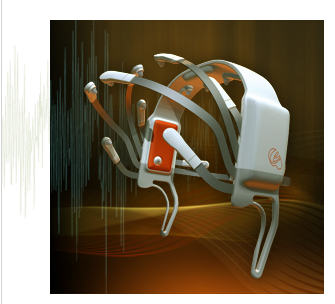Stanford EE Computer Systems Colloquium
4:15PM, Wednesday, April 9th, 2008
HP Auditorium, Gates Computer Science Building B01
http://ee380.stanford.edu
Demonstration of Brain Computer Interface using the Emotiv Epoc
Randy Breen
Emotiv Systems Inc.
About the talk:
Emotiv Systems will demonstrate the use of their brain computer interface device
The following information and more can be found at www.emotiv.com.
 |
Overview
Communication between human and machine has always been limited to
conscious interaction, with non-conscious communication -- expression,
intuition, perception -- reserved solely for the human realm. At Emotiv,
we believe that future communication between human and machine will not
be limited to the conscious communication that exists today. Users will
demand that non-conscious communication play a much more significant role.
Emotiv's mission is to create the ultimate interface for the
next-generation of human-machine interaction, by evolving the interaction
between humans and electronic devices beyond the limitations of conscious
interface. Emotiv has created technologies that allow machines to take
both conscious and non-conscious inputs directly from your mind.
Applications for Emotiv technology spans numerous industries, however,
our immediate target market is entertainment, with a focus on the
electronic games industry.
|
Emotiv EPOC™
The Emotiv EPOC now makes it possible for games to be controlled and
influenced by the player's mind. Engaging, immersive, and nuanced,
Emotiv-inspired game-play will be like nothing ever seen before. Based
on the latest developments in neuro-technology, Emotiv has developed a
new personal interface for human computer interaction.
The Emotiv EPOC uses a set of sensors to tune into electric signals
naturally produced by the brain to detect player thoughts, feelings and
expression. It connects wirelessly with all game platforms from consoles
to PCs. The Emotiv neuroheadset now makes it possible for games to be
controlled and influenced by the player's mind.
Technology
Using non-invasive electroencephalography (EEG), it is possible to observe
each person's individual electrical brain activity. At Emotiv, we've
created a robust system and methodology for detecting and classifying both
human conscious thoughts and non-conscious emotions. This revolutionary
patent pending neural processing technology makes it possible for
computers to interact directly with the human brain. By the detection
of thoughts and feelings, our technology now makes it possible for
applications to be controlled and influenced by the user's mind.
Slides:
Download the slides for the presentation
in PDF format.
Organizers Commentary:
Research towards direct man-machine communication has been going on for a
long time. Some researchers have been experimenting with direct neuron-computer
connections. See, for example, Peter Fromhertz's Colloquium talk, Joining
Ionics and Electronics Semiconductor Chips with Ion Channels, Nerve Cells and
Brain Tissue given February 9, 2005 (
Colloquium Talks 2004-2005).
The idea of capturing signals to do "mind-reading" has been both the subject of
science fiction and serious research. Some of the early work was done at SRI by
Lawrence Pinneo and his colleagues. Time magazine published an articles
Mind-reading computer in July 1974.
Lawrene Pinneo and David J. Hall's 1975 SRI report to DARPA
Feasibility Study for Design of a Biocybernetic Communication System
makes interesting reading.
Here are a few different mind-reading devices that appear on the net.
It is sometimes difficult to tell when people are serious. Some kind of
direct mind-reading like control of computers has practical implications. It
can be done using measurement of brain activity or
examination of facial movements. Some people find
the idea quite distrubing and want to block psycotronic mind control. For them,
there is the tin foil beanie, but studies
at MIT have shown it to be ineffective.
About the speaker:
Randy Breen, Chief Product Officer, is a legend within the electronic
games industry. Prior to joining Emotiv, Randy was the Vice President
and Head of Development at LucasArts. Products developed during Randy's
tenure at LucasArts sold in record-breaking numbers and received numerous
honors including the Academy of Interactive Arts and Sciences' Game of
the Year award.
In 1986, Randy began working at Electronic Arts, where he was responsible
for the creation and production of the Road Rash™ game franchise, which
sold over four million units and played an important role in the success
of EA.
Over the span of his career, Randy has produced and managed over
fifty titles. As Emotiv's Executive Vice President and Chief Product
Officer, Randy's intimate knowledge of game development helps him
guide the direction of research and ensure the product reaches its
market potential. His industry contacts and knowledge of the publishing
business also play a vital role in establishing partnerships within the
game industry.
Contact information:
Randy Breen
600 Townsend St
Penthouse
San Francisco, CA 94103
415-552-2335
415-276-8955
randy@emotiv.com
